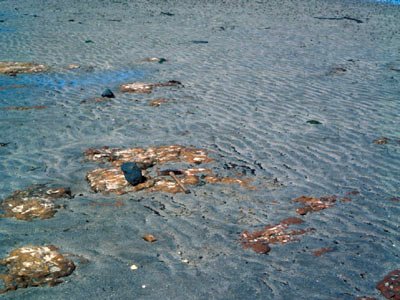Earth Science Conservation Review
| Brown's Bay, Island Magee | Antrim |
| Site Type: | Coastal section |
| Site Status: | local interest |
| Council area: | Larne Borough Council |
| Grid Reference: | D435028 |
| Google maps: | 54.85281,-5.76564 |
| Rocks | |
|---|---|
| Rock Age: | Tertiary, Cretaceous, Triassic (Eocene, Palaeocene, Rhaetian, Santonian, Scythian) |
| Rock Name: | Antrim Lava Group, Interbasaltic Formation, Mercia Mudstone Group, Ulster White Limestone Formation |
| Rock Type: | Basalt, Bauxite, Limestone, Mudstone |
| Interest | |
| Other interest: | fault, Lacustrine sediments, Marine sediments, lacustrine, tropical sea |
Summary of site:
There is a concentration of stratigraphical and structural interest on this site.
On the eastern side of the bay, at low tide, expanses of Cretaceous Ulster White Limestone are clearly evident, separated by a fault from the much earlier red-brown Triassic marls of the Mercia Mudstone Group to the west. The White Limestone forms well-defined beds and is separated from the basalt above by a layer of red-stained clay with flints. This used to be considered a soil, lying on the limestone landscape, buried by the first lavas of the Tertiary eruptions around 60 million years ago. It is now interpreted as a welded volcanic ash which formed in an exceptionally violent volcanic event. Along the fault there are thin smears and slivers of Hibernian Greensand containing the green mineral glauconite. The Greensand is also Cretaceous in age and lies immediately below the White Limestone. The fault also yields thin lenses of grey mudstone with limestone fragments of the Jurassic Waterloo Mudstone Formation, more clearly seen below the Greensand across the lough north of Larne.
Across the fault on the western side are the rich red-brown marls of the even earlier Triassic Mercia Mudstone Group - puzzling because they contain blocks of basalt, white limestone and flint, all of which are later in age than Triassic rocks. The most rational explanation for their presence is that they were caught up in explosive volcanic activity close to the vent of a volcano and settled with the severely disrupted marls.
Also on the western side of the bay, the total thickness of the Interbasaltic Bed can be seen. Its base is an orange-red bauxite passing into yellow streaked bauxite, topped off by a purplish-grey crumbly rock called a lithomarge. The Interbasaltic Bed is the topmost level of the Lower Basalts which was deeply weathered and denatured in a sub-tropical climate in the long volcanic hiatus before the eruption of the Upper Basalts.
This variety of rocks, faults and unusual related features makes Brown's Bay a superb natural classroom. Over the years it has proved ideal for the teaching of basic geological mapping techniques.
On the eastern side of the bay, at low tide, expanses of Cretaceous Ulster White Limestone are clearly evident, separated by a fault from the much earlier red-brown Triassic marls of the Mercia Mudstone Group to the west. The White Limestone forms well-defined beds and is separated from the basalt above by a layer of red-stained clay with flints. This used to be considered a soil, lying on the limestone landscape, buried by the first lavas of the Tertiary eruptions around 60 million years ago. It is now interpreted as a welded volcanic ash which formed in an exceptionally violent volcanic event. Along the fault there are thin smears and slivers of Hibernian Greensand containing the green mineral glauconite. The Greensand is also Cretaceous in age and lies immediately below the White Limestone. The fault also yields thin lenses of grey mudstone with limestone fragments of the Jurassic Waterloo Mudstone Formation, more clearly seen below the Greensand across the lough north of Larne.
Across the fault on the western side are the rich red-brown marls of the even earlier Triassic Mercia Mudstone Group - puzzling because they contain blocks of basalt, white limestone and flint, all of which are later in age than Triassic rocks. The most rational explanation for their presence is that they were caught up in explosive volcanic activity close to the vent of a volcano and settled with the severely disrupted marls.
Also on the western side of the bay, the total thickness of the Interbasaltic Bed can be seen. Its base is an orange-red bauxite passing into yellow streaked bauxite, topped off by a purplish-grey crumbly rock called a lithomarge. The Interbasaltic Bed is the topmost level of the Lower Basalts which was deeply weathered and denatured in a sub-tropical climate in the long volcanic hiatus before the eruption of the Upper Basalts.
This variety of rocks, faults and unusual related features makes Brown's Bay a superb natural classroom. Over the years it has proved ideal for the teaching of basic geological mapping techniques.
| Enlander, I., Dempster, M. & Doughty, P., 2025. Brown's Bay, Island Magee, County Antrim, site summary. [In] Earth Science Conservation Review. https://www.habitas.org.uk/escr/summary.php?item=1197. Accessed on 2025-04-05 |
| Previous Site | Next Site |


